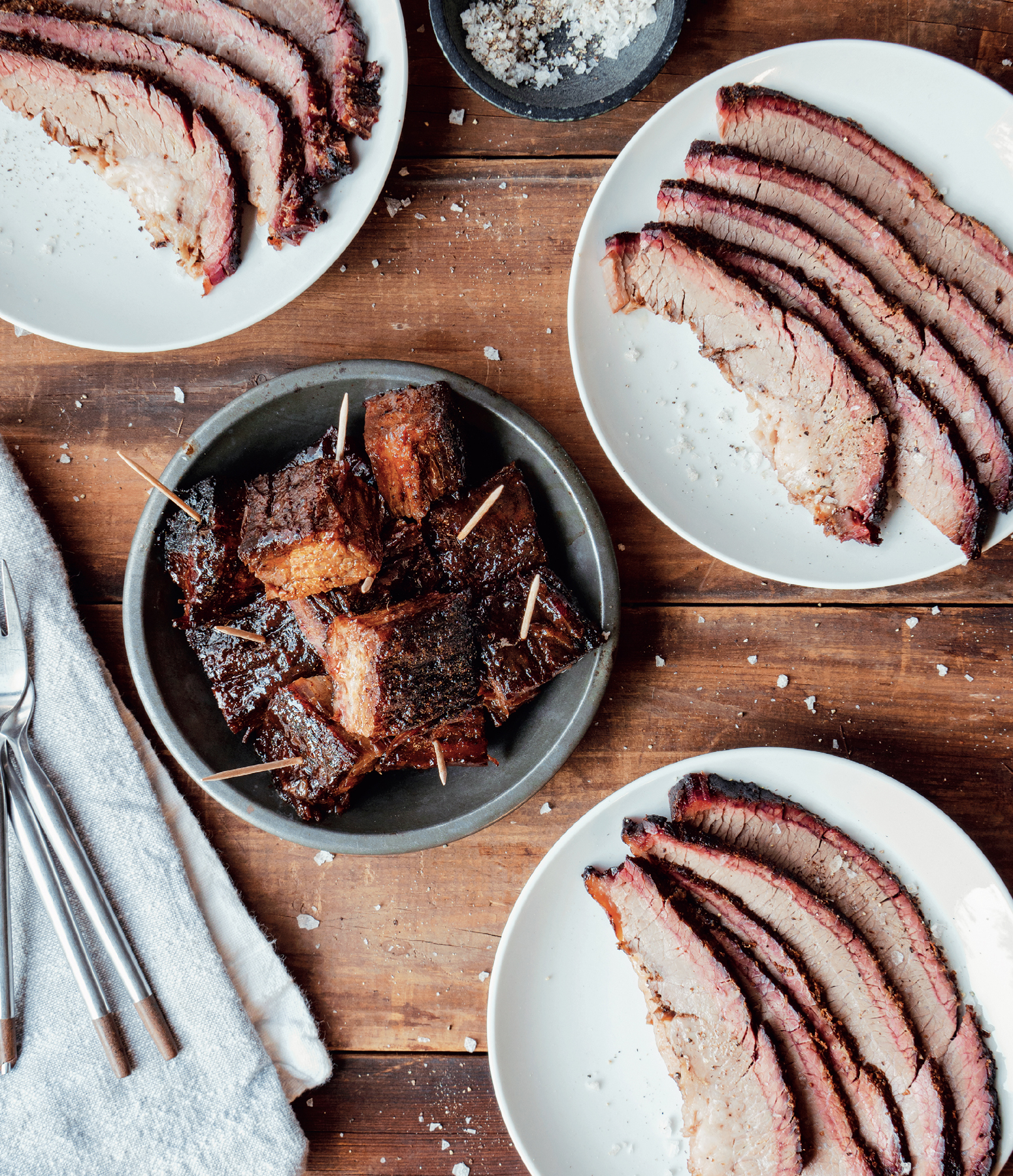TEXAS-STYLE BRISKET AND BURNT ENDS
Makes about 8 to 10 servings
In Texas, a melt-in-your-mouth brisket with a smoky and peppery crust is king. Burnt ends, however, are a standard of quality in Kansas City barbecue. This recipe gives you the best technique of both barbecue regions. A whole packer brisket is simply seasoned with salt and pepper (a.k.a. Dalmatian rub), before being slow smoked for hours to break down the connective tissues in the meat. After cooking, the point (fatty) end of the brisket is cubed and tossed with BBQ sauce and cooked again to render fat and give the delicious nuggets of meat candy a sweet and sticky glaze.
1 (12- to 14-lb [5.4- to 6.4-kg]) whole choice grade or higher packer beef brisket
¼ cup (60 ml) olive oil
½ cup (150 g) kosher salt
½ cup (51 g) ground black pepper
1 cup (240 ml) Kansas City BBQ Sauce (here)
Place the brisket, fat side up, on a cutting board and trim the fat down to about ¼ inch (6 mm). Turn the meat over and trim all fat pockets and silver skin from the surface of the meat. Cut away any loose or gray edges to retain its shape and appearance.
Place the brisket in a large disposable aluminum pan and rub all over with the olive oil. Sprinkle the salt and pepper evenly over the meat and press firmly with your hand to adhere the spices.
Cover and refrigerate the brisket for at least 4 hours and up to overnight.
Set up the EGG for 275°F (140°C), indirect with a drip pan. Fill your firebox with natural lump charcoal, layering it with four or five chunks of smoking wood. For brisket, I like to use oak or hickory wood. With the top and bottom vents wide open, light the fire and close the EGG. After about 10 minutes, close the bottom draft screen. When the temperature nears your 275°F (140°C) target temperature, partially close the bottom vent door and the top of the daisy wheel, leaving both vents 15 percent open. Make minor adjustments as necessary.
Once the cooker reaches temperature, place the brisket, fat side down, on the cooking grate and close the lid. Cook until the internal temperature of the brisket reaches 165°F (73°C), 4 to 5 hours.
Using heavy insulated gloves, transfer the brisket, with the fat side down, to a double layer of aluminum foil or butcher paper and wrap it up tightly. Place the wrapped brisket back on the smoker and cook until the internal temperature reaches 198 to 203°F (92 to 95°C) and a thermometer pushed into the meat gives little resistance.
Remove the brisket from the smoker and open the wrap to vent for 10 to 15 minutes. Strain the accumulated juices of their fat into a bowl and allow it to cool. Refrigerate the jus until ready to use.
Close the foil or butcher paper and wrap the brisket in a clean towel; place in an empty, dry cooler to rest for a minimum of 1 hour.
Place the reserved liquid in a medium-sized saucepan and bring to a simmer over medium heat.
Prepare the burnt ends: Once rested, transfer the brisket to a large cutting board. Separate the flat from the point. This is done by using a large carving knife to slice along the fat that is between the two muscles. Wrap the flat back up and return it to the dry cooler.
Cut the point into 1-inch (2.5-cm) cubes and place the meat in a disposable aluminum half pan. Add ¼ cup (60 ml) of the reserved liquid and the BBQ sauce and place it back on the cooker for 1 hour. Remove the pan from the smoker and gently coat the burnt ends with the sauce, then place it back on the cooker for 15 minutes to set the glaze.
While you are waiting for the burnt ends to finish, slice the brisket against the grain about the thickness of a number 2 pencil (about ¼ inch [6 mm] thick). You can slice it a little thicker if it is overcooked or a little thinner if it is a bit tougher, to get the tenderness just right.
Dip each slice of brisket in the warmed jus and arrange on a platter with the burnt ends to serve.
